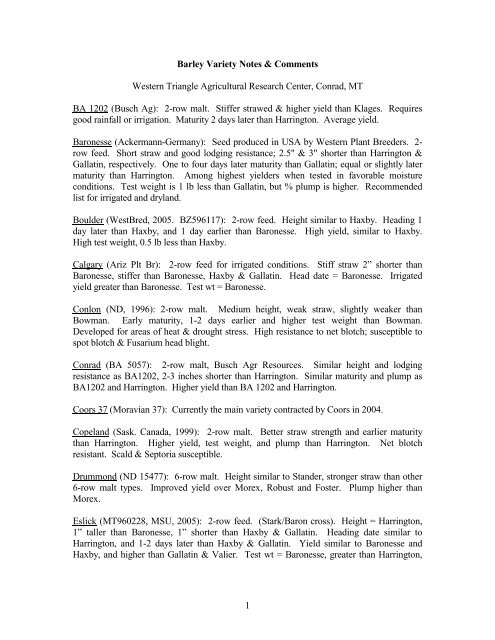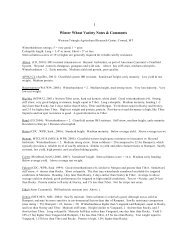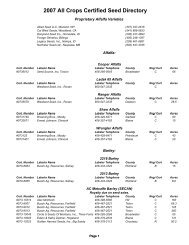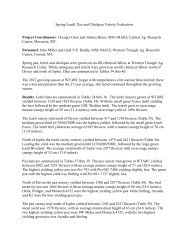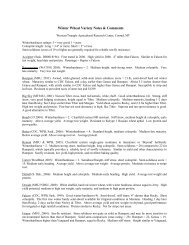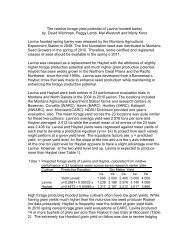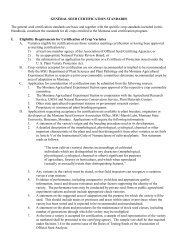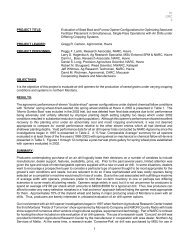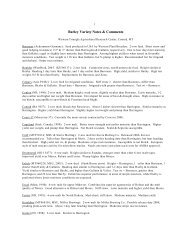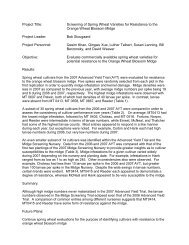Barley Variety Notes & Comments
Barley Variety Notes & Comments
Barley Variety Notes & Comments
You also want an ePaper? Increase the reach of your titles
YUMPU automatically turns print PDFs into web optimized ePapers that Google loves.
<strong>Barley</strong> <strong>Variety</strong> <strong>Notes</strong> & <strong>Comments</strong>Western Triangle Agricultural Research Center, Conrad, MTBA 1202 (Busch Ag): 2-row malt. Stiffer strawed & higher yield than Klages. Requiresgood rainfall or irrigation. Maturity 2 days later than Harrington. Average yield.Baronesse (Ackermann-Germany): Seed produced in USA by Western Plant Breeders. 2-row feed. Short straw and good lodging resistance; 2.5" & 3" shorter than Harrington &Gallatin, respectively. One to four days later maturity than Gallatin; equal or slightly latermaturity than Harrington. Among highest yielders when tested in favorable moistureconditions. Test weight is 1 lb less than Gallatin, but % plump is higher. Recommendedlist for irrigated and dryland.Boulder (WestBred, 2005. BZ596117): 2-row feed. Height similar to Haxby. Heading 1day later than Haxby, and 1 day earlier than Baronesse. High yield, similar to Haxby.High test weight, 0.5 lb less than Haxby.Calgary (Ariz Plt Br): 2-row feed for irrigated conditions. Stiff straw 2” shorter thanBaronesse, stiffer than Baronesse, Haxby & Gallatin. Head date = Baronesse. Irrigatedyield greater than Baronesse. Test wt = Baronesse.Conlon (ND, 1996): 2-row malt. Medium height, weak straw, slightly weaker thanBowman. Early maturity, 1-2 days earlier and higher test weight than Bowman.Developed for areas of heat & drought stress. High resistance to net blotch; susceptible tospot blotch & Fusarium head blight.Conrad (BA 5057): 2-row malt, Busch Agr Resources. Similar height and lodgingresistance as BA1202, 2-3 inches shorter than Harrington. Similar maturity and plump asBA1202 and Harrington. Higher yield than BA 1202 and Harrington.Coors 37 (Moravian 37): Currently the main variety contracted by Coors in 2004.Copeland (Sask. Canada, 1999): 2-row malt. Better straw strength and earlier maturitythan Harrington. Higher yield, test weight, and plump than Harrington. Net blotchresistant. Scald & Septoria susceptible.Drummond (ND 15477): 6-row malt. Height similar to Stander, stronger straw than other6-row malt types. Improved yield over Morex, Robust and Foster. Plump higher thanMorex.Eslick (MT960228, MSU, 2005): 2-row feed. (Stark/Baron cross). Height = Harrington,1” taller than Baronesse, 1” shorter than Haxby & Gallatin. Heading date similar toHarrington, and 1-2 days later than Haxby & Gallatin. Yield similar to Baronesse andHaxby, and higher than Gallatin & Valier. Test wt = Baronesse, greater than Harrington,1
and 2# less than Haxby. Eslick has superior performance in areas of ample moisture, whileHaxby is preferred where lower moisture conditions are expected.Excel (Minn, 1990): 6-row malt for upper Midwest. Combines the superior agronomics ofRobust and the malt quality of Morex. Good alternative to Robust and Morex. Stiff straw.Later maturity and higher yield than Morex.Foster (ND, 1995): 6-row malt for North Dakota. Med-short; stiff straw. Mediummaturity. Medium yield.Gallatin (MSU, 1986): 2-row feed. Med-short height; stiff straw and good lodgingresistance (more than Hector, Klages, Lewis, and Clark). Medium maturity, slightly earlierthan Hector, and earlier than Bearpaw. Yields high in both dry and wet conditions; thus abroadly adapted feed barley. Good drought tolerance.Garnet (ID, 1998): 2-row malt. Similar to Harrington.Harrington (Sask. Can): 2-row malt. Medium height; medium weak straw. Late maturity.Sensitive to hot dry areas; yields good in moist areas. Can sprout or germinate (internalfalling number) at a lower moisture content than other varieties. Sweating in the bin can beenough to ruin germination. Susceptible to skinning unless carefully threshed.Haxby (MSU 2002, MT950186): 2-row feed. 3 inches taller and two days earlier thanBaronesse. Yield is equal to Baronesse, and is among highest yielders in Triangle Area.Highest test weight of all varieties. Non-Baronesse derived, providing good diversity.Haxby has superior performance in lower moisture conditions, while Eslick is the preferredchoice for high moisture conditions.Haybet (MSU): 2-row, hooded hay barley. Later to mature than Horsford, and higherforage yield. Similar to Horsford for grain yield, which is low. Harvest at soft doughstage. Caution: any cereal grain grown for hay should be tested for nitrate level prior tocutting.Hays (MSU, 2004): MT981060. Hooded 2-row. Shorter than Haybet and more resistant tolodging. Higher grain yield than Haybet (similar to Harrington). Test wt = Haybet, and 2#less than Harrington. Higher forage yield than Haybet and Westford (8%). Harvest at softdough stage. Caution: any cereal grain grown for hay should be tested for nitrate levelprior to cutting.Kendall (Can): 2-row malt. High irrigated yield.Lacey (M98, MN 1999): 6-row malt. Intended to replace Robust. Height intermediatebetween Robust & Stander. Lodging resistance greater than Robust, but less than Stander.2
Legacy (Busch Ag 2978; 6B932978): 6-row malt. 2 to 4 inches taller than Harrington.Higher yield than Morex and Robust, but lower than Harrington. Has 30% resistance tovomatoxin.Manley (TR 409) (Canada): 2-row. Slightly stiffer strawed and three days later thanHarrington, (approx. Klages maturity); longer shelf life than Harrington - does not lose itsgermination as bad. May replace Harrington in Canada; but only in high rainfall, stripe rustareas.Merit (Busch Ag): 2-row malt. Late maturing, too late for dryland. Lodges easier than1202 and Harrington, but yields higher. Net blotch resistance, and moderate Scaldresistance.Merlin, Westbred (WPB): Waxy seed, semidwarf. Better yield and lodging resistance thanWaxbar, but quality not accepted by Japan markets yet.Metcalfe (Manitoba Canada, 1994): 2-row malt. Possible replacement for Harrington.Higher yield, test weight and plump than Harrington. Slightly earlier to head thanHarrington. Moderate resistance to spot-form net blotch. Susceptible to scald andSeptoria.Morex (Minn, 1978): 6-row malt. Tall; medium straw strength. Early maturity. Shattersreadily - swathing advised. Agronomically the worst malting barley on the list. Excel maybe a better choice.MT910189 : Experimental 2-row malt for dryland. 4 days earlier than Harrington, andretains plump on dryland much better than Harrington. 5 bu/a higher yield thanHarrington. Plant-scale test planned for 2005.Prowashonupana (line 3) (MSU): 2-row hulless. Does not have soluble B-glucan unlessthey can find a way to steam process it out. Potential specialty market.Robust (Mn, 1983): 6-row malt. Tall; medium straw strength. Medium maturity. The1992 Robust crop in Minnesota did not malt due to dormancy for unknown reasons.Growers therefore switched to 'Stander' in 1993.Shonkin (MSU): Waxy 2-row hulless. Stands up better than Wanubet, but has weak strawand low yield. Heads slightly later than Hector. Up to 10% or more of the grain may notthresh free from the hulls. Shonkin is LR 247 from Wanubet (a separate variety fromWanubet) and is a "clean seed" source of Wanubet to allow a more pure line. Special use,with no recommendation.Stander (M-64, Minn, 1993): 6-row malt for upper Midwest. Med-short straw, stiffer thanother 6-row malt types. Medium-late maturity. Better yield stability and kernel-plump thanExcel, but Excel seems to be preferred by growers.3
Steptoe (Wash): 6-row feed. Among the highest yielders on irrigation or dryland. Verylow test weight dryland.Stockford (WestBred, 2005). 2-row hooded hay barley. Height is 2” taller than Hays.Heading is 2 days earlier than Hays. Forage yield is similar to Hays and Haybet. Harvestat soft dough stage. Caution: any cereal grain grown for hay should be tested for nitratelevel prior to cutting.Tradition (Busch Ag, BA6B95-2482): 6-row malt. Stiffer straw than Legacy, goodlodging resistance. Higher yield than Legacy.Valier (MSU 1999): 2-row feed. Lewis/Baroness cross 10% better feed efficiency(rumenal digestibility) and 10% better ADG in cattle. Agronomically superior to Gallatinand Lewis, but less than Baroness. Better head extension out of boot than Baroness. H3860224 (MSU): Released as a germplasm. Slightly higher feed value than Valier.Wanubet (MSU, 1990): Waxy 2-row hulless. The B-glucan line that will most likely beindustrialized. Weak straw and low yield (70% of Hector or Gallatin). Med-late mat. Upto 10% or more of the seed may not thresh free from the hulls.Waxbar, Westbred (WPB): Waxy barley grown under contract in 1994 & 1995 for exportto Japan. Standard height and fairly late to mature. See Merlin.Westford, Westbred (WPB): 6-row hooded hay barley. Maturity considerably later thanHorsford and Whitford, allowing for greater forage production. Seed yield low (similar toHorsford). Hay yields considerably higher than Horsford. Harvest at soft dough stage.Hooded barleys are sometimes vulnerable to ergot, but the amount is slight. Cautionshould be taken to avoid high nitrate levels when using any small grain as a forage. Testforage for nitrate before the crop is harvested.Westbred 501 (WPB): 6-row feed. Very stiff straw (supposedly doesn't lodge). Marketedmainly in Idaho.Xena (WPB bz594-19): baroness/stark cross. 2-row feed. Two inches taller and betterboot emergence than Baroness. Lodging resistance equal to Baroness. Late maturity,similar to Baroness. Better adapted to dryland than Baroness, (higher test wt and plumpthan Baroness on dryland4


